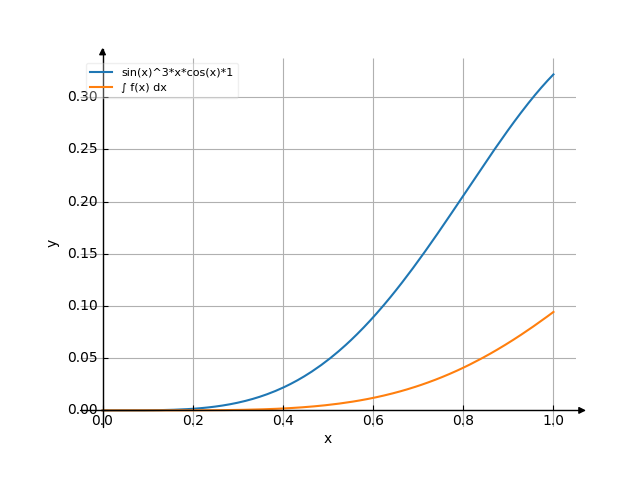Integral of (sin^3)xcosxdx dx
The solution
1 / | | 3 | sin (x)*x*cos(x)*1 dx | / 0
Integral(sin(x)^3*x*cos(x)*1, (x, 0, 1))
-
Use integration by parts:
Let and let .
Then .
To find :
-
There are multiple ways to do this integral.
Method #1
-
Let .
Then let and substitute :
-
The integral of is when :
Now substitute back in:
-
Method #2
-
Rewrite the integrand:
-
Let .
Then let and substitute :
-
Integrate term-by-term:
-
The integral of a constant times a function is the constant times the integral of the function:
-
The integral of is when :
So, the result is:
-
-
The integral of a constant is the constant times the variable of integration:
The result is:
-
Now substitute back in:
-
-
Now evaluate the sub-integral.
-
-
The integral of a constant times a function is the constant times the integral of the function:
-
Rewrite the integrand:
-
There are multiple ways to do this integral.
Method #1
-
Rewrite the integrand:
-
Integrate term-by-term:
-
The integral of a constant times a function is the constant times the integral of the function:
-
Rewrite the integrand:
-
Integrate term-by-term:
-
The integral of a constant times a function is the constant times the integral of the function:
-
Let .
Then let and substitute :
-
The integral of a constant times a function is the constant times the integral of the function:
-
The integral of cosine is sine:
So, the result is:
-
Now substitute back in:
-
So, the result is:
-
-
The integral of a constant is the constant times the variable of integration:
The result is:
-
-
So, the result is:
-
-
The integral of a constant times a function is the constant times the integral of the function:
-
Let .
Then let and substitute :
-
The integral of a constant times a function is the constant times the integral of the function:
-
The integral of cosine is sine:
So, the result is:
-
Now substitute back in:
-
So, the result is:
-
-
The integral of a constant is the constant times the variable of integration:
The result is:
Method #2
-
Rewrite the integrand:
-
Integrate term-by-term:
-
The integral of a constant times a function is the constant times the integral of the function:
-
Rewrite the integrand:
-
Integrate term-by-term:
-
The integral of a constant times a function is the constant times the integral of the function:
-
Let .
Then let and substitute :
-
The integral of a constant times a function is the constant times the integral of the function:
-
The integral of cosine is sine:
So, the result is:
-
Now substitute back in:
-
So, the result is:
-
-
The integral of a constant is the constant times the variable of integration:
The result is:
-
-
So, the result is:
-
-
The integral of a constant times a function is the constant times the integral of the function:
-
Let .
Then let and substitute :
-
The integral of a constant times a function is the constant times the integral of the function:
-
The integral of cosine is sine:
So, the result is:
-
Now substitute back in:
-
So, the result is:
-
-
The integral of a constant is the constant times the variable of integration:
The result is:
-
-
So, the result is:
Add the constant of integration:
The answer is:
/ | 4 | 3 3*x sin(4*x) sin(2*x) x*sin (x) | sin (x)*x*cos(x)*1 dx = C - --- - -------- + -------- + --------- | 32 128 16 4 /
4 4 2 2 3 3
3*cos (1) 5*sin (1) 3*cos (1)*sin (1) 3*cos (1)*sin(1) 5*sin (1)*cos(1)
- --------- + --------- - ----------------- + ---------------- + ----------------
32 32 16 32 32
=
4 4 2 2 3 3
3*cos (1) 5*sin (1) 3*cos (1)*sin (1) 3*cos (1)*sin(1) 5*sin (1)*cos(1)
- --------- + --------- - ----------------- + ---------------- + ----------------
32 32 16 32 32

Use the examples entering the upper and lower limits of integration.

![Find the integral of y = f(x) = (sin³)xcosxdx ((sinus of cubed)x co sinus of e of xdx) - with detailed solution [THERE'S THE ANSWER!] (sin^3)xcosxdx](/media/krcore-image-pods/176/hash/indefinite/3/d0/f4933c3f2a1baba55cf0a52fa051a.png)
 Integral of (4x-x^2)dx
Integral of (4x-x^2)dx
 Integral of (2x+1)^3
Integral of (2x+1)^3
 Integral of x^5*dx
Integral of x^5*dx